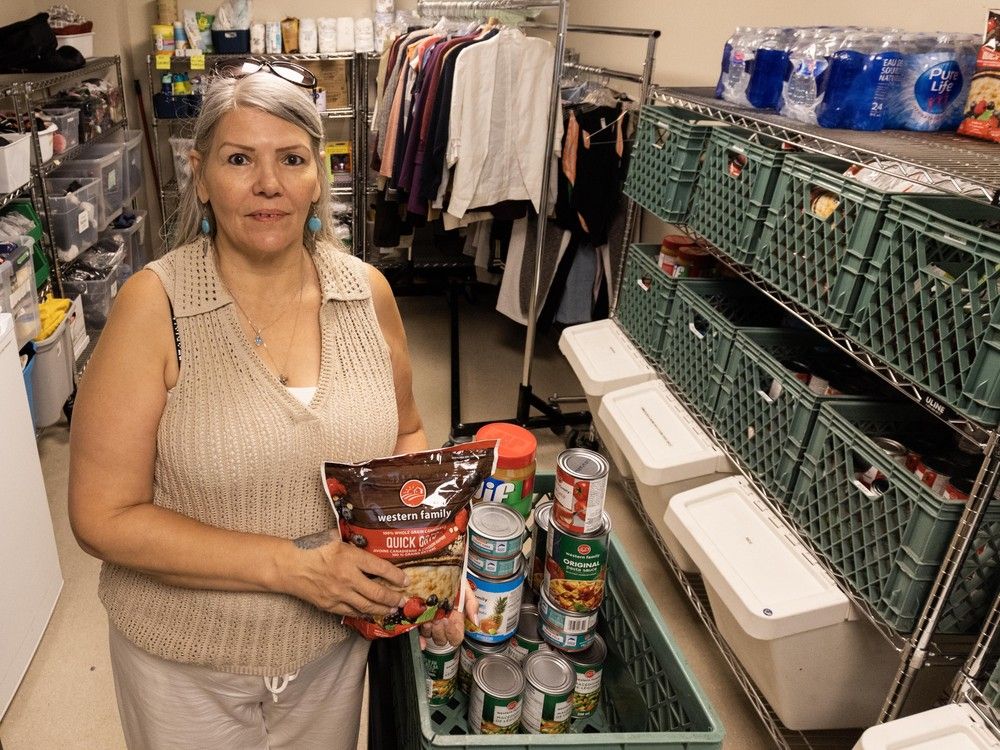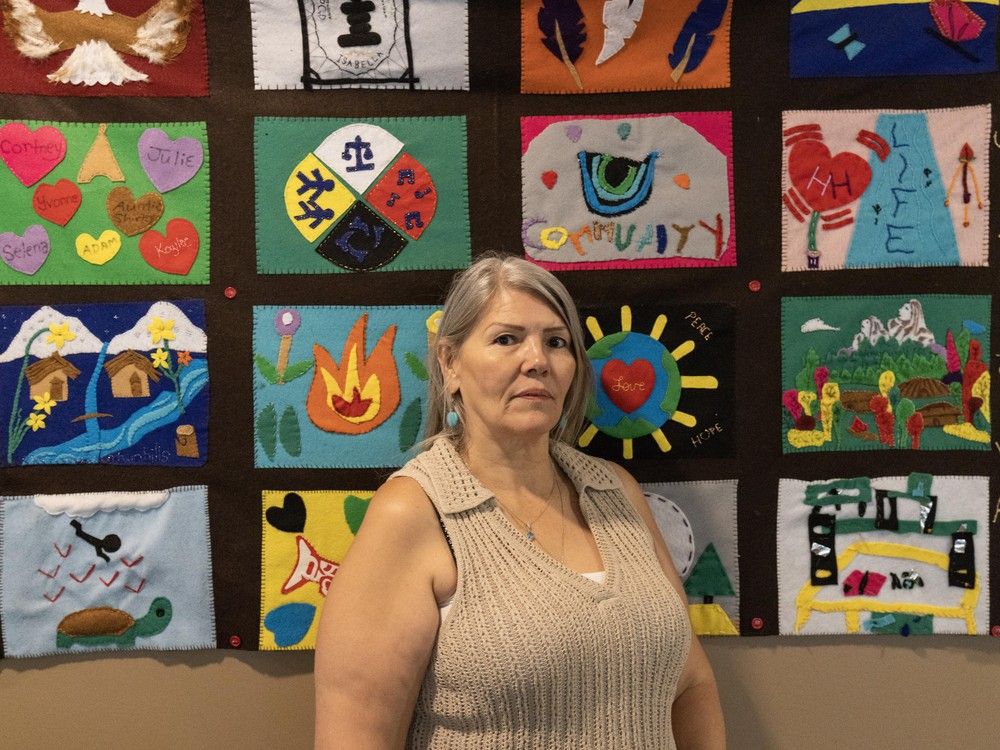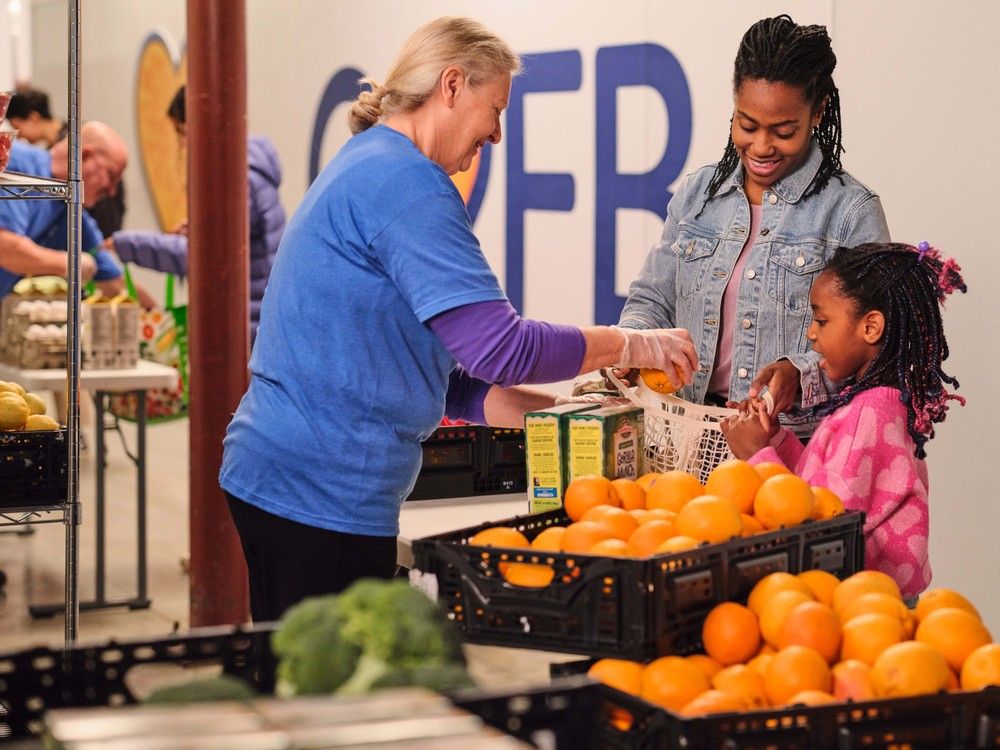
Hazel Arnold knows a thing or two about feeding a family. She raised 11 children, four of her own and seven nieces and nephews she adopted after her sister died.
And the 63-year-old is now raising two granddaughters, ages 10 and 16.
But feeding young mouths is an increasingly hard thing to do with grocery prices rising and inflation pushing up the cost of nearly everything in a city that’s already famous for being expensive.
Arnold, like many low-income British Columbians, more frequently turns to charities to help fill her cupboards. For the past couple of years, she has been picking up food hampers from Union Gospel Mission in the Downtown Eastside.
“In the hampers, we get pasta, rice, canned vegetable, canned fruit, spaghetti sauce, mixed vegetables, soups, peanut butter, tuna, baked beans, split peas. Everything is high protein. So, it makes you feel like you’re not really chintzing out on your kids,” she said.
“Without that program, I don’t know where me and my grandkids would be.”
UGM started the food hamper program in 2020 to help Downtown Eastside residents get groceries while social distancing during the early days of the pandemic. It gave away about 150 hampers a month that year, primarily to families.
The need for the hampers has grown every year, with more than 330 handed out each month in 2023 and 2024. That has more than doubled this year, with 4,100 distributed by the end of June — or more than 680 a month.
“There’s food insecurity, cost-of-living expenses … Raising kids is a lot of money, too,” said UGM spokesperson Nick Wells. “But food insecurity is not just a Downtown Eastside problem. It is everywhere across the province and further.”
Visits to food banks across B.C. have nearly doubled since 2019, and one out of every third person who relies on the service is a child, says the organization Food Banks B.C.
“We’re still clearly headed in the wrong direction,” said the Food Banks B.C. executive director, Dan Huang-Taylor. “There is a continued demand for hunger relief services. … British Columbians are going hungry just to get by.”
UGM distributes hampers from its Women and Families Centre, where it has a room filled with supplies. Besides pantry items like oatmeal or lentils, there are baby items, feminine hygiene products, and gift cards for fresh fruits and vegetables from a nearby market.

Arnold, who is unable to work due to past injuries, said the program boosts her dignity, allowing her to make homemade food, such as peanut butter cookies or apple crisp, for her granddaughters.
“People like myself need that. Without that, we’d really have nothing to look forward to. We’d probably slip into a deep depression,” she said.
The Métis woman raised 11 kids on a farm in Saskatchewan before she and her partner decided a few years ago to buy a motor home and move to Vancouver. A series of life events, though, including the death of her partner, led to financial challenges and eventually homelessness.
While living with her two grandchildren in an RV beside Oppenheimer Park, she went to UGM for showers, meals, programs, and to pray for help.
“I was lost. I was completely beside myself because everything that could go wrong went wrong.”
Each client can only pick up a UGM hamper once every three months, so Arnold tries to make the food last by, for example, making a big pot of spaghetti sauce and freezing it in small containers.
For the past nine months, she and her granddaughters have lived in social housing run by a non-profit, paying rent deemed to be “affordable” compared to Vancouver’s prices. But she still finds it prohibitively high.
Her income includes welfare, a child supplement and a rent rebate, but after paying $1,875 for rent and her utility bills, she runs out of money for groceries before the end of each month.
Having the apartment is better for her grandchildren. But financially, she said bluntly, “I was better off homeless.”
“It’s really hard to budget when there’s nothing to budget with,” she said. “It’s sad.”
UGM’s Wells knows there is a clear need for more food hampers, so someone like Arnold can get one more than once every three months. But the non-profit is doing what it can, he said, with its limited funding and supplies.
It spends about $10,000 a month on food hampers, primarily funded through donations .

Food insecurity, he argued, “needs to be urgently addressed by all levels of government.”
While the province and Ottawa have pledged support for school meal programs , other ways to access healthy food must also be funded — especially in the summer when kids are not in class, Wells said.
Meaningful change, Wells said, includes governments building more affordable housing, so families have more money to spend on groceries.
“One in three kids across the country are going hungry or not sure where their next meals may come from. That’s a huge stress for the kids. That’s a huge stress for the parents too — dealing with that kind of emotional baggage of ‘How do I provide for my family?'”
The hampers help to address the intergenerational trauma of parents who grew up without enough to eat and now worry how they will feed their own children, Wells added.
At the Greater Vancouver Food Bank, 4,800 children were registered as clients between October and December, 2024. From January to March of this year, the most recent statistics available, that jumped by 20 per cent to 5,800 children, said communications manager Taylor McLean.

The 111 food-distribution agencies that are members of Food Banks B.C. have experienced increased demand in 2025, and at the same time roughly half of them had a “notable drop” in both food and financial donations this year, Huang-Taylor said.
“You can really start to appreciate how hard it is to sustain the demand for services in those conditions,” he said. “We’re in a cost-of-living crisis. An increasing number of people just cannot keep up with the cost of life’s essentials.”
Demand is high in rural communities where groceries tend to be more expensive due to transportation costs. In urban centres, help is being sought by a range of people, including residents with high rents and new arrivals to Canada.
Related
The top reasons people cite for relying on food banks, Huang-Taylor said, are grocery prices, low wages, and the cost of housing. Families and the working poor are among the fastest-growing client groups, as they will often cut their food budget so they can pay other bills.
“The profile of the food bank user has changed,” he said. “The people who need to access services are our co-workers, friends and family.”
Solutions, Huang-Taylor said, include the province improving social assistance rates and disability benefits, and boosting the minimum wage to a living wage; municipalities having more community gardens so people can grow food; and citizens and corporations continuing to donate to food banks.